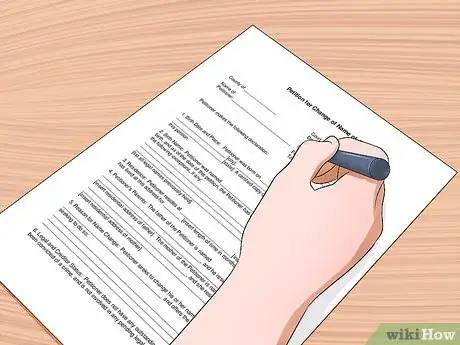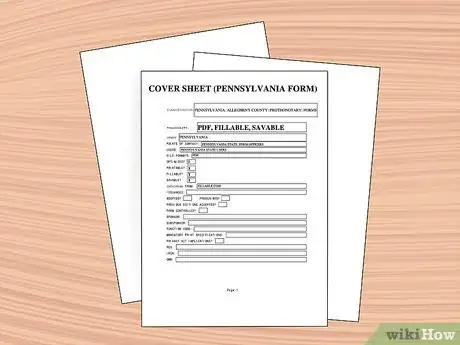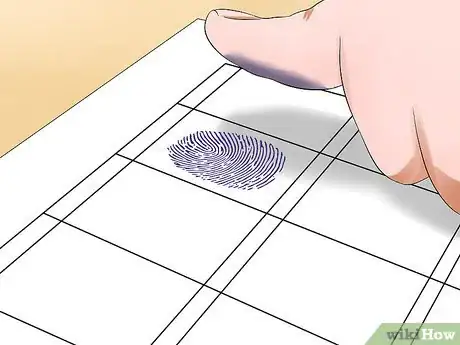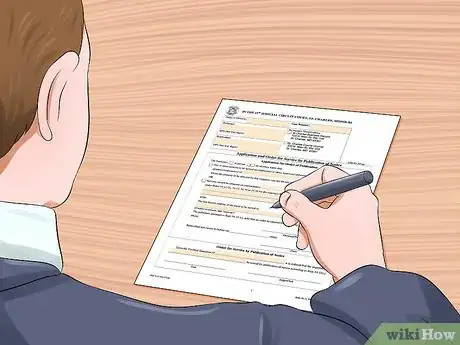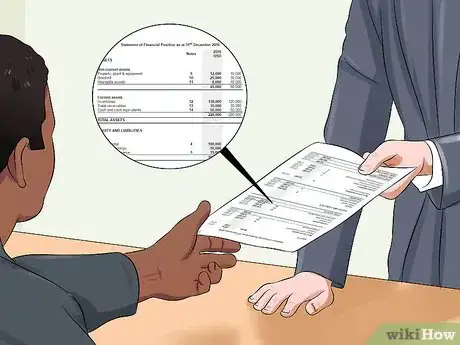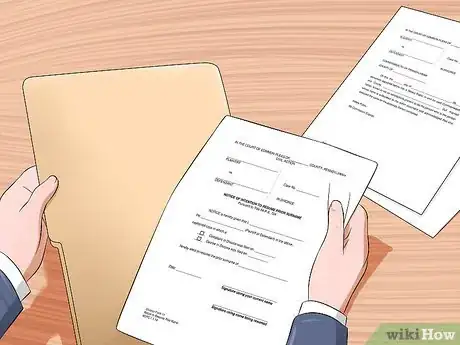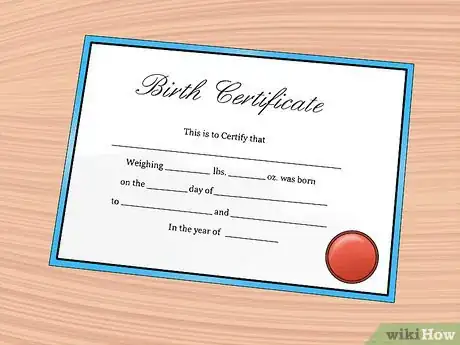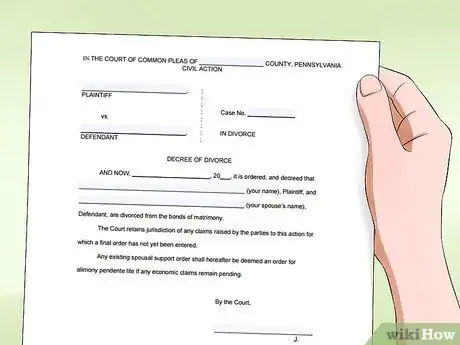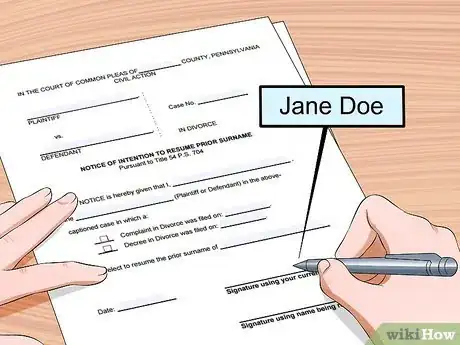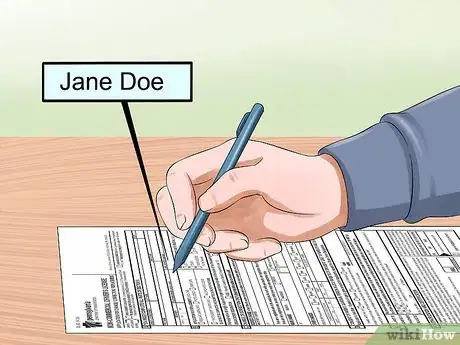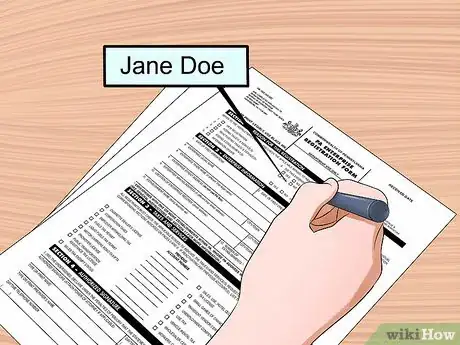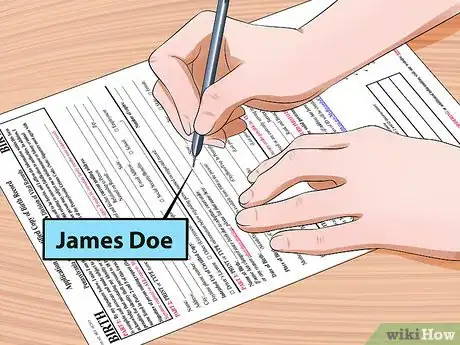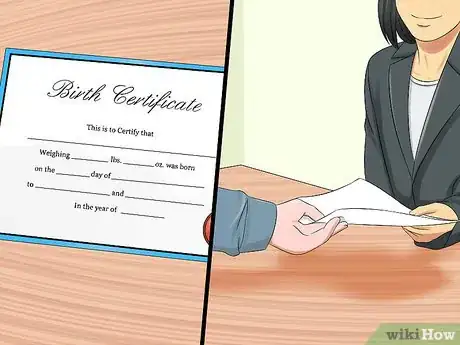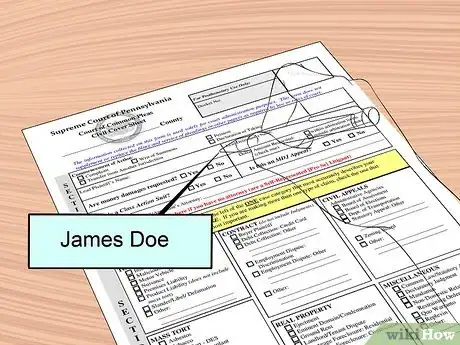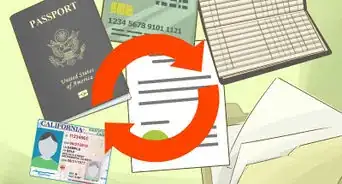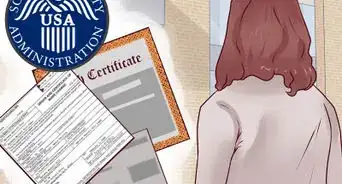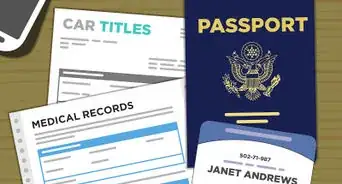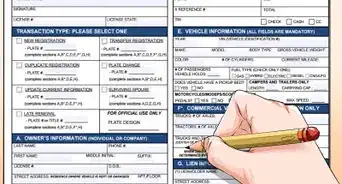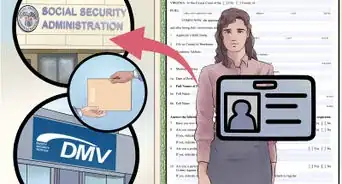This article was co-authored by Clinton M. Sandvick, JD, PhD. Clinton M. Sandvick worked as a civil litigator in California for over 7 years. He received his JD from the University of Wisconsin-Madison in 1998 and his PhD in American History from the University of Oregon in 2013.
There are 9 references cited in this article, which can be found at the bottom of the page.
This article has been viewed 176,508 times.
Many people wish to change their names, or the name of their minor child, in order to get a new start in life. Pennsylvania law governs the procedures by which a person’s name can be changed in the state of Pennsylvania.[1] The Office of the Prothonotary (also called the "Office of Judicial Records" in some places) in your county of residence is where you will submit the documents necessary to change your name. This office is typically located in each county’s courthouse.[2] There are different procedures to follow, depending on the reason for changing your name and whether it involves an adult or a minor child. It is up to the court whether to order a name change.
Steps
Changing Your Name for Personal Reasons
-
1File a Petition for Name Change in your local Prothonotary’s office. You should file your paperwork in the county in which you live. Some Prothonotary offices have sample petitions for you to fill out. Other offices require that you write your own petition. This step starts the name change process.[3] Your petition must contain the following information:
- Your desire and intention to change your name
- Your reason for asking for a name change, which can be any reason that the Court will approve. However, you may not change your name to avoid creditors, commit fraud, or because you don’t want others to know that you have committed crimes in the past.
- Your current address
- All of your addresses for the five years prior to filing your petition
-
2File any other required forms. These forms differ in each county. However, they may include a Civil Cover Sheet, a Court Administration Office Scheduling Sheet, and an Order for Publication and Notice. Your county Prothonotary office may have these forms for you to fill out, or you may need to write your own forms. These forms are usually just to ensure that your case moves properly through the court system and that you complete all of the required steps to change your name.Advertisement
-
3Pay the court’s filing fee. The amount of this fee varies widely from county to county, ranging from about $97.00 to $328.00. You can file an In Forma Pauperis (IFP) petition and order if needed. This petition asks the court to waive the normal fee because you receive public assistance or are otherwise unable to afford the fee or are considered to be low-income. If the judge agrees to waive the court’s fee, you will receive a signed order waiving the filing fee by mail.[4]
-
4Get your fingerprints taken. When you file your Petition for Change of Name, the court will issue an order that directs you to have your fingerprints taken. You may be able to receive that order from the court the same day that you file your petition, or you may receive it later in the mail. Using this order, you can set up an appointment with your local police department in order to get your fingerprints taken. The police department is likely to charge you a fee to get your fingerprints taken. The court will use your fingerprints to check your criminal history with the Pennsylvania State Police. If you have been convicted of certain crimes, you may not be eligible to change your name.[5]
-
5Get an Order for Publication and Notice signed by the judge. After your fingerprints have been submitted, the court will schedule a hearing. You will receive a hearing date by mail, along with a completed Order for Publication and Notice. This Order directs you to publish notice that you wish to change your name.
-
6Publish notice of your intended name change. Your notice also will contain the date of the hearing that has been scheduled on your request to change your name. This allows any interested person to attend the hearing and object to your proposed name change.[6] Your publication notice must follow these guidelines:
- The notice must be published one time in two newspapers of general circulation in your county of residence or in a nearby county. You can use any newspaper in those locations. Since the fees may vary, you may wish to check with several newspapers to see which costs less. Your Prothonotary’s Office can tell you which newspapers are generally used and how to contact them.
- A copy of the newspaper notice will serve as evidence that you have properly published the notice of your intended name change.
- The court can waive the publication requirement if it finds that publishing notice would jeopardize your safety.
-
7Present proof of financial standing to the court. You typically satisfy this requirement by submitting an official judgment or lien check showing no outstanding judgments. This document must be signed by the Prothonotary’s office. Depending on your county’s requirements, you also may need to get searches done by the Clerk of Court’s Office and the Recorder of Deeds Office. You must provide proof of these searches to the court.
- You must request that these searches be performed individually by each office. Each office may have a different form for making this request. Some offices in some counties may even require you to conduct the search yourself.
- The Prothonotary’s Office and the Clerk of Court’s Office are typically located in your county courthouse. The Recorder of Deeds Office also may be in the courthouse or in another local government building, depending on your county.
- Each office may charge a fee for the search requests. The amount of this fee is different in every office and varies from one county to the next.
- Once you have paid the fee and the search is complete, the office will give you a signed document that states the results of the search. This is the document that you will present to the court when you attend your hearing.
-
8Attend a court hearing. Your court hearing typically will be about one to three months from the date that your petition for name change is filed. This gives you plenty of time to publish the required notices. At the court hearing, the court will determine if you are eligible for a name change. If you qualify under Pennsylvania law, the court will order your name change. Some people do not qualify for a name change. If the judge denies your petition for name change, you do have the right to appeal. However, the appeal process is complex and you probably should consult with an attorney first before attempting to file an appeal on your own. You will not be eligible for a name change for the following reasons:
- To avoid creditors or debts that you owe
- To commit fraud or similar criminal acts
- To avoid people knowing about your past criminal convictions
Changing Your Name When You are Newly Divorced
-
1Obtain the required forms. An Election or Notice to Resume Maiden Name form for an adult who wants to change her name after a divorce is generally available in most Prothonotary offices in each county. Filing this form will allow you to change your name from a married surname to a prior surname if you are newly divorced.[7] The Prothonotary’s office will charge a fee to change your name. This fee typically ranges from $19.00 for a person who was divorced in her county of residence, to $42.00 for a person who was divorced in another county or state. However, these fees vary by county.
-
2Obtain a copy of your birth certificate. If you wish to resume using your maiden name following a divorce, you must provide a copy of your birth certificate that shows your maiden name.
-
3Get a certified copy of your divorce decree, if required. If your divorce was filed in another county or state, you will need to place a certified copy of your divorce decree on file in the Prothonotary’s office. You can get a certified copy of the divorce decree from the Prothonotary office in the county in which you were divorced, or from the county clerk’s office if you were divorced in another state. If your divorce was granted in the county in which you are filing for a name change, you do not need to provide a copy of your divorce decree to the Prothonotary’s office.
-
4File the completed Election or Notice to Resume Maiden Name form, birth certificate, and divorce decree in the Prothonotary’s office. Once you have filed the required paperwork, you have effectively given notice of your intent to return to using a prior surname. This is all you have to do to start using your prior name under Pennsylvania law.
Changing Your Name When You Are Newly Married
-
1Change your name with the Social Security Administration. You can change your name on your social security card to your spouse’s surname by bringing your marriage certificate to your local Social Security Administration branch office. You also will need to present a copy of a valid photo identification card, such as a driver’s license. There is no fee for changing your name with the Social Security Administration. You will receive your new social security card in the mail.[8]
-
2Change your name on your driver’s license. You can change your name on your driver’s license to your spouse’s surname by bringing your marriage certificate to your local Driver License Center and filling out Form DL-80.[9] There is no fee for simply changing your name on your driver’s license.
-
3Change your name on other important documents. Once you have obtained a new social security card and driver’s license showing your new married surname, you can take those documents to other offices to have your name changed there, as well. Some places will want to see your marriage certificate along with your new social security card and driver’s license, and they may require you to fill out their own internal forms in order to change your name. Other places where you may need to change your name include:
- Your employer
- Institutions that service your retirement accounts
- Banks and credit unions
- Credit card accounts
- Insurance policies, including medical, dental, vision, life, and disability
Changing Your Minor Child’s Name When Both Parents Agree
-
1Complete and sign the back of the child’s birth certificate. When both biological parents agree to change their child’s name, they don’t have to do it through the court system. There is a form located on the back of every child’s birth certificate for this purpose. Both biological parents must sign this form to show their agreement.
-
2Mail the form to the Department of Vital Statistics. You must include a legible copy of one parent’s government-issued ID card with the form. If you want the original birth certificate returned to you, you also must include a $4 fee. The only exception is if you provide proof of membership in the Armed Forces. In that case, you don’t have to pay the $4 fee.[10]
-
3Receive a new birth certificate with your child’s new name. You can use the new birth certificate to change your child’s name with the Social Security Administration. You also should show the new birth certificate to other offices that need the child’s correct name, such as his or her school and doctor’s office.
Changing Your Minor Child’s Name When Parents Don’t Agree
-
1Consult with an attorney. Changing the name of a minor child can be complicated. The court does not have to grant your request to change your child’s name. An attorney can evaluate your situation and advise you whether you are likely to be successful in changing your child’s name.
-
2File a petition to change your child’s name. You must file the petition in the Court of Common Pleas in the county in which you live.
-
3Pay the court’s filing fee. The amount of this fee may vary. You can file an IFP (in forma pauperis) petition and order if needed. This petition asks the court to waive the normal fee because you are unable to afford the fee or are considered to be low-income. If the judge agrees to waive the court’s fee, you will receive a signed order waiving the filing fee by mail.
-
4Serve the child’s other parent with notice. A court cannot change the name of a minor child without the other parent getting notice. You must send notice of the petition for name change to the other parent by registered or certified mail. You should ask for a return receipt when mailing the notice. You must file the return receipt along with a certificate of service with the court. This proves that you properly gave notice to the other parent.[11]
-
5Prove that the name change is in the best interest of the child. The court will hold a hearing to determine if the child’s name should be changed. The best interest of the child standard includes a number of different factors to consider.
- The natural bond between parent and child
- The parent’s history of visitation with child
- Whether the parent has paid child support
- Whether the parent has been consistently involved in child’s life
- Whether ties exist between the child and the parent’s extended family
- The social impact or respect according the child’s present name in the community
- The age and ability of the child to understand the significance of changing his or her name
Warnings
- A court is not required to change your name.⧼thumbs_response⧽
- A court will not change your name if you are doing it to avoid credit problems, your prior criminal history, or to commit fraud.⧼thumbs_response⧽
- Whenever an adult’s name is changed, the surname of any minor child under his or her care will also automatically be changed along with the adult’s name, unless indicated otherwise. [12]⧼thumbs_response⧽
- If the court orders your name change, you still will have to take steps to change your name with other government offices in order to get a new social security card and driver’s license or identification card.⧼thumbs_response⧽
References
- ↑ http://www.legis.state.pa.us/WU01/LI/LI/CT/HTM/54/00.007..HTM?_ga=1.200433772.332901170.1432562322
- ↑ http://www.pacourts.us/courts/courts-of-common-pleas/prothonotaries
- ↑ http://www.palawhelp.org/resource/changing-your-name
- ↑ http://www.courts.phila.gov/pdf/forms/domestic-relations/prose-ifp.pdf
- ↑ http://www.legis.state.pa.us/WU01/LI/LI/CT/HTM/54/00.007..HTM?_ga=1.200433772.332901170.1432562322
- ↑ http://info.legalzoom.com/change-legal-name-pennsylvania-20319.html
- ↑ http://www.palawhelp.org/resource/changing-your-name
- ↑ http://www.ssa.gov/pubs/EN-05-10513.pdf
- ↑ http://www.dot.state.pa.us/Public/DVSPubsForms/BDL/BDL%20Form/DL-80.pdf
About This Article
If you need to change your name in Pennsylvania, you’ll need to visit the Office of the Prothonotary or the Office of Judicial Records in your county to submit the necessary documents. If you want to change your name for personal reasons, file a Petition for Name Change. While some offices have a sample petition for you to fill out, other offices require that you write your own petition, which must cover your reason for changing your name, your current address, and all of your addresses for the 5 years prior to your petition. You’ll also need to have your fingerprints taken to make sure you don’t have a criminal record and get an order for Publication and Notice signed by the judge. In addition to the paperwork, pay the filing fee, which can range from around 97 dollars to 328 dollars. To complete the process, publish a notice of your intended name change in the newspaper, present proof of your financial standing to the court, and attend a court hearing. To learn how to change your name when you’re newly divorced or married, keep reading!
